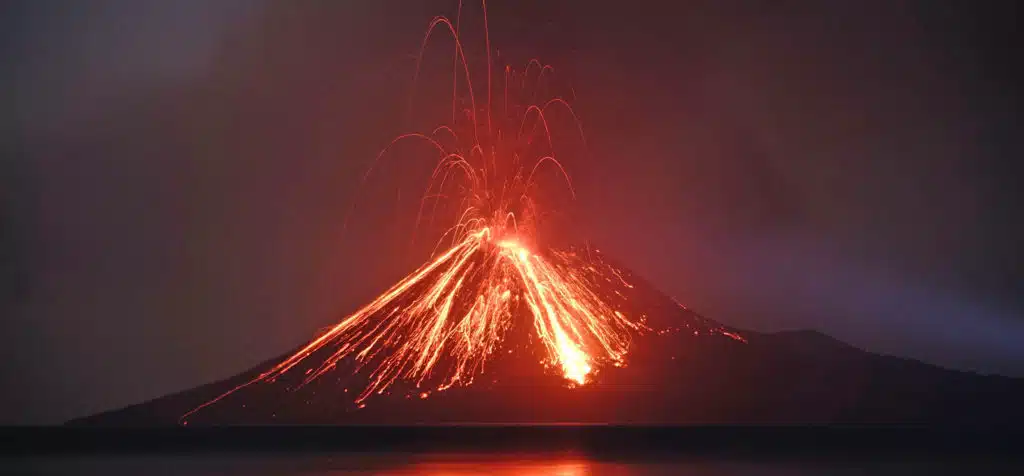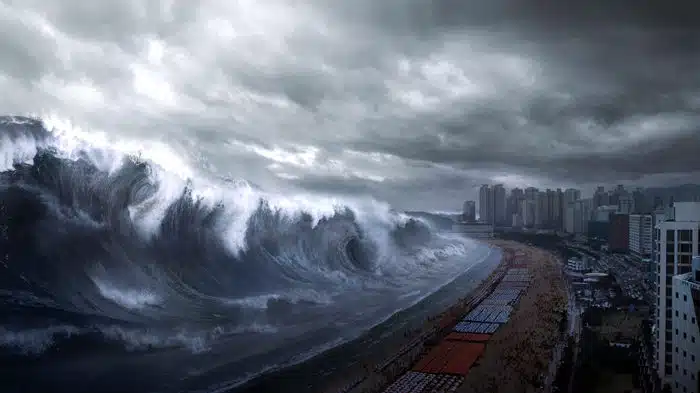Second Trumpet: The Seas Struck
In the first trumpet judgment, a 1/3 of the vegetation of the earth was burned up. Now at the sound of the second trumpet John saw “something like a great mountain burning with fire” and it’s thrown into the sea (Revelation 8:8-9). This judgment turns a 1/3 of the sea into blood and in turn causes a 1/3 of the sea life to perish and destroys a 1/3 of the ships.
With the death of a 1/3 of the sea life means a decrease in food sources from the sea. This will also have an affect on the ecosystem and how humanity obtains drinkable water. There are two common interpretations for what this “great mountain burning with fire” that John saw could be:
- A large meteor that makes its way to earth
- A volcano or portion of a volcano that collapses into the ocean
The first interpretation is a common one and is often a “doomsday” scenario you’d see in apocalyptic movies so not much explanation is needed for us to understand the possible fallout from such an event. The force of this object crashing into the ocean would create massive aftershocks resulting in a mega-tsunami with huge waves that will make their way worldwide destroying ships and devastating coastal cities. However, what’s not often discussed is how this could be interpreted as a volcano rather than a meteor of some kind.

Just like the meteor scenario, this too is a viable one. For example, on the south flank of Hawaii’s Kilauea volcano is an area known as Hilina Slump – a landslide. The Hilina Slump is a portion of the volcano that has been sliding into the ocean at a pace of 4 inches per year.
Recent volcanic activity coupled with the slump’s movements has sparked talks of a possible mega-tsunami scenario that may occur if this portion of Kilauea volcano collapses into the ocean completely. Despite these fears, geologists largely believe such a scenario isn’t possible and is over-sensationalized.
In an article by The Atlantic titled The Most Destructive Wave in Earth’s (Known) History, geologists look into the past to see how the collapse of an African volcano’s flank in the distant past could have created mega-tsunamis and moved a giant boulders half a mile inland in an event that they believe could very well be the largest mega-tsunami preserved in the geological record, “Ramalho and his colleagues identified giant boulders almost half a mile inland, hundreds of feet above sea level, that they believe were transported by a mega-tsunami. Based on what they found, the scientists believe the tsunami swelled to a height of about 560 feet, tall as the Washington Monument, before inundating the island.”
The article then moves to discuss Hawaii’s history with flank collapses and mega-tsunamis. It states that these scenarios are rare but have occurred and can occur in the future.
Most scientists agree that a catastrophic flank collapse will generate an unimaginably massive tsunami again someday, but they’re cautious about guessing when it might happen. A popular ballpark estimate: maybe sometime within the next 100,000 years. Whatever the case, a volcanic-flank collapse in Hawaii would generate a series of giant tsunamis that would likely destroy cities in several countries, including in the United States, Canada, Japan, and China, McGuire says.
On one hand, based on their research the geologists believe the potential destruction this could create shouldn’t be underestimated but at the same time, it’s nothing to panic about, “The hazard of these ‘very low-frequency, very high-impact’ geologic events should not be underestimated, Ramalho told me, but the potential for such catastrophes shouldn’t cause panic either.”
Another article by UC Berkeley’s Seismology Lab titled A Slow Emergency and a Sudden Slump echoed similar sentiments concerning what a flank collapse of a volcano would entail.
A complete failure of the cliff at the southern side of Hawaii along the extensional Hilina Fault system, however, would generate a huge, sudden disaster. It is estimated that about 10 percent of the island’s total volume could be affected by the collapse. The huge slide could generate a magnitude 9 quake, which is comparable to the largest earthquakes ever measured. It would also generate a megatsunami with an estimated wave height of more than 1000 feet throughout the islands. Geologic records show that about 110,000 years ago, long before any of the adventurous Polynesian seafarers had reached the island chain, Hawaii was rocked by such a slump and engulfed in the resulting huge tsunami. However, a repeat of such a rare catastrophic event is highly unlikely and it may take many millennia for it to occur. (hra155)
What we’ve read about thus far and speculated on is the potential damage that could occur if the flank of a volcano collapsed. However, Revelation 8:8 seems to paint a slightly different picture in my opinion, “Then the second angel sounded: And something like a great mountain burning with fire was thrown into the sea…” (Revelation 8:8).
The second trumpet judgment isn’t just a portion of a volcano that it’s referring to, but if the correct interpretation of this verse is indeed a volcano then the scenario the bible outlines for us may very well be the whole volcano collapsing or rapidly submerging in the sea which would be even more catastrophic than what we’ve read about above with just a portion of the volcano collapsing.
Whichever interpretation one believes, the result is still the same – unprecedented destruction on an unrepentant humanity. My purpose in going into depth on these judgments is to warn those who have yet given their lives to God about the coming tribulation period.
Sources
- A Slow Emergency and a Sudden Slump (May 7th, 2018) – Berkeley Seismology Lab
- The Most Destructive Wave in Earth’s (Known) History (October 23rd, 2015) – The Atlantic




 Support the Ministry
Support the Ministry